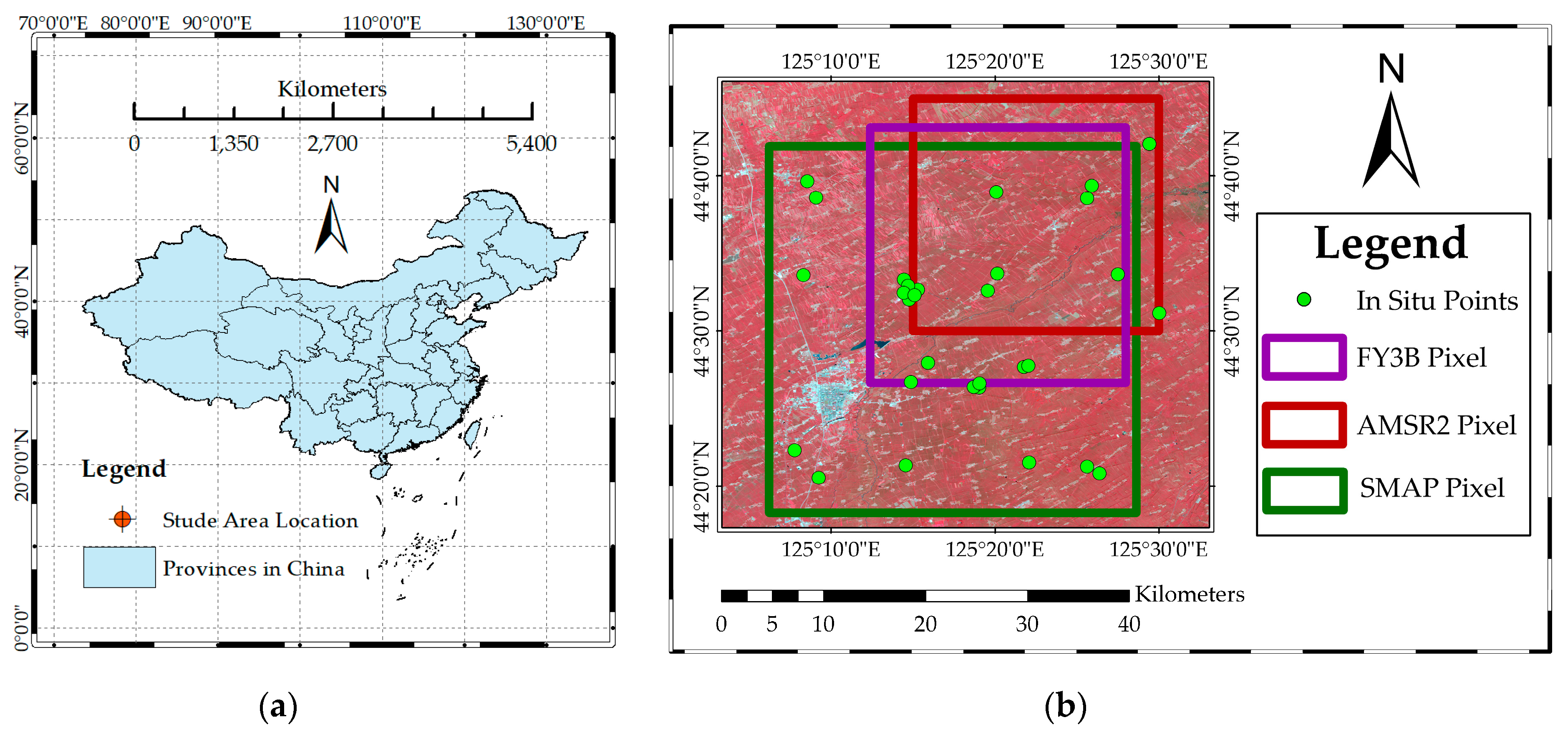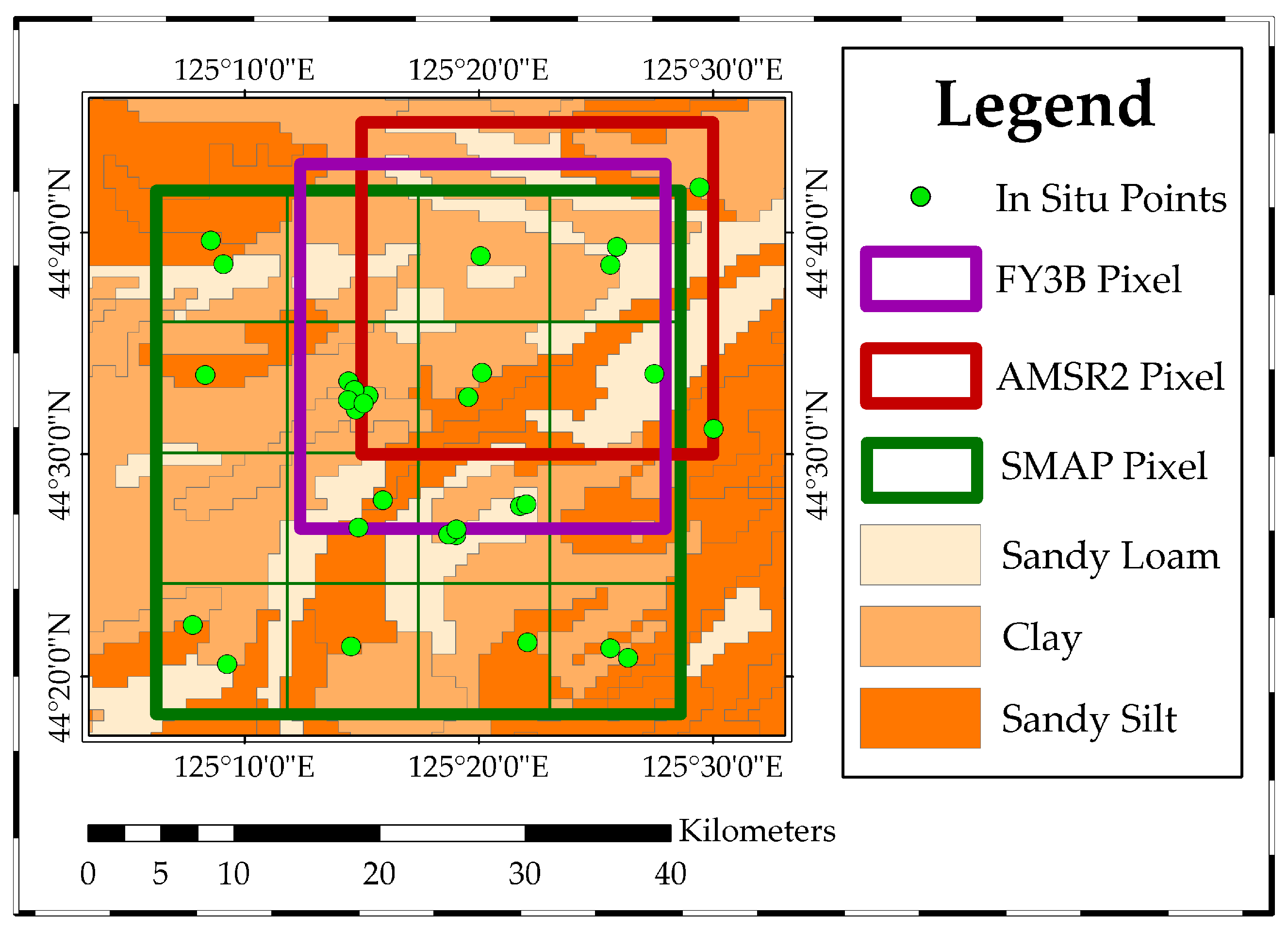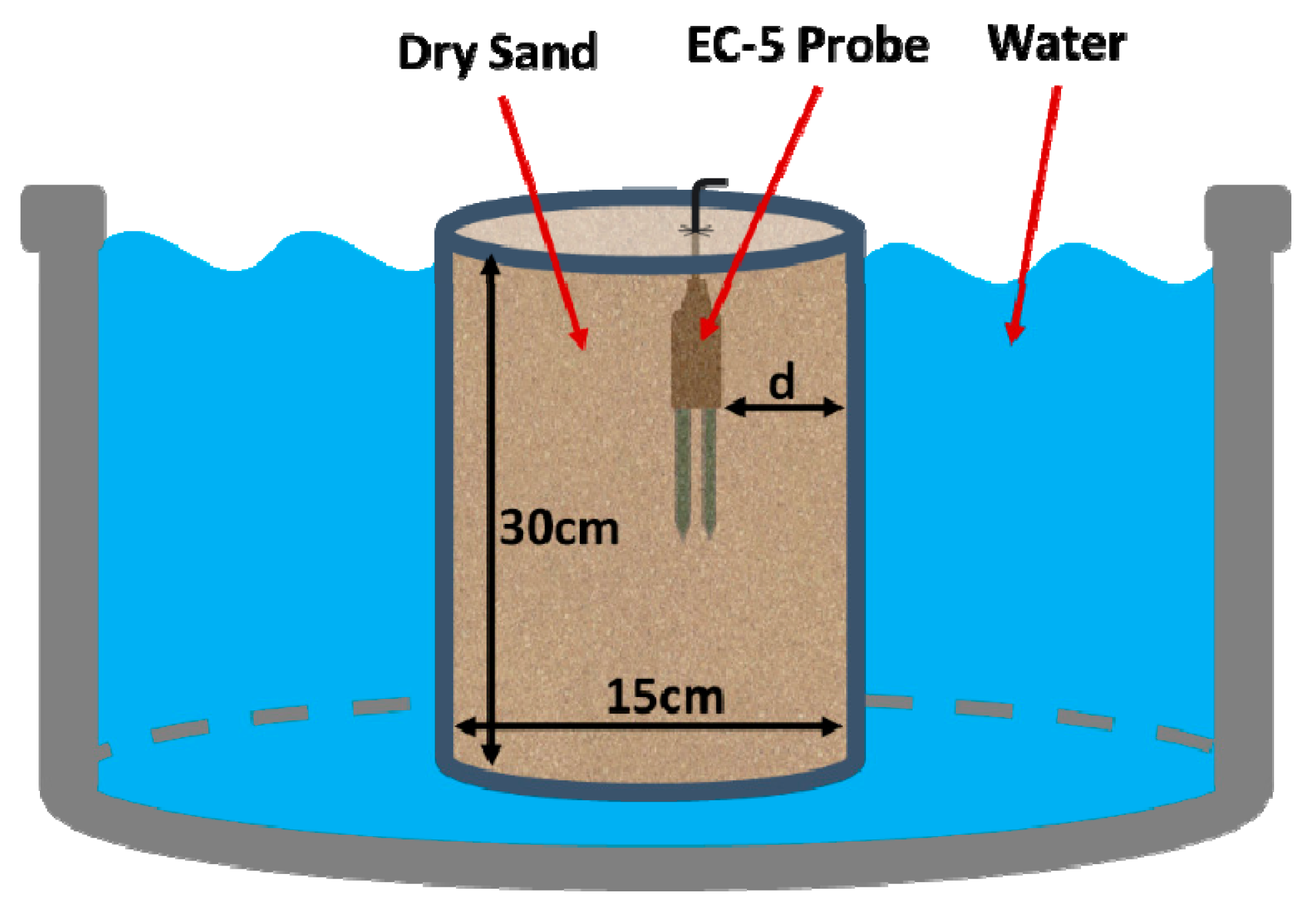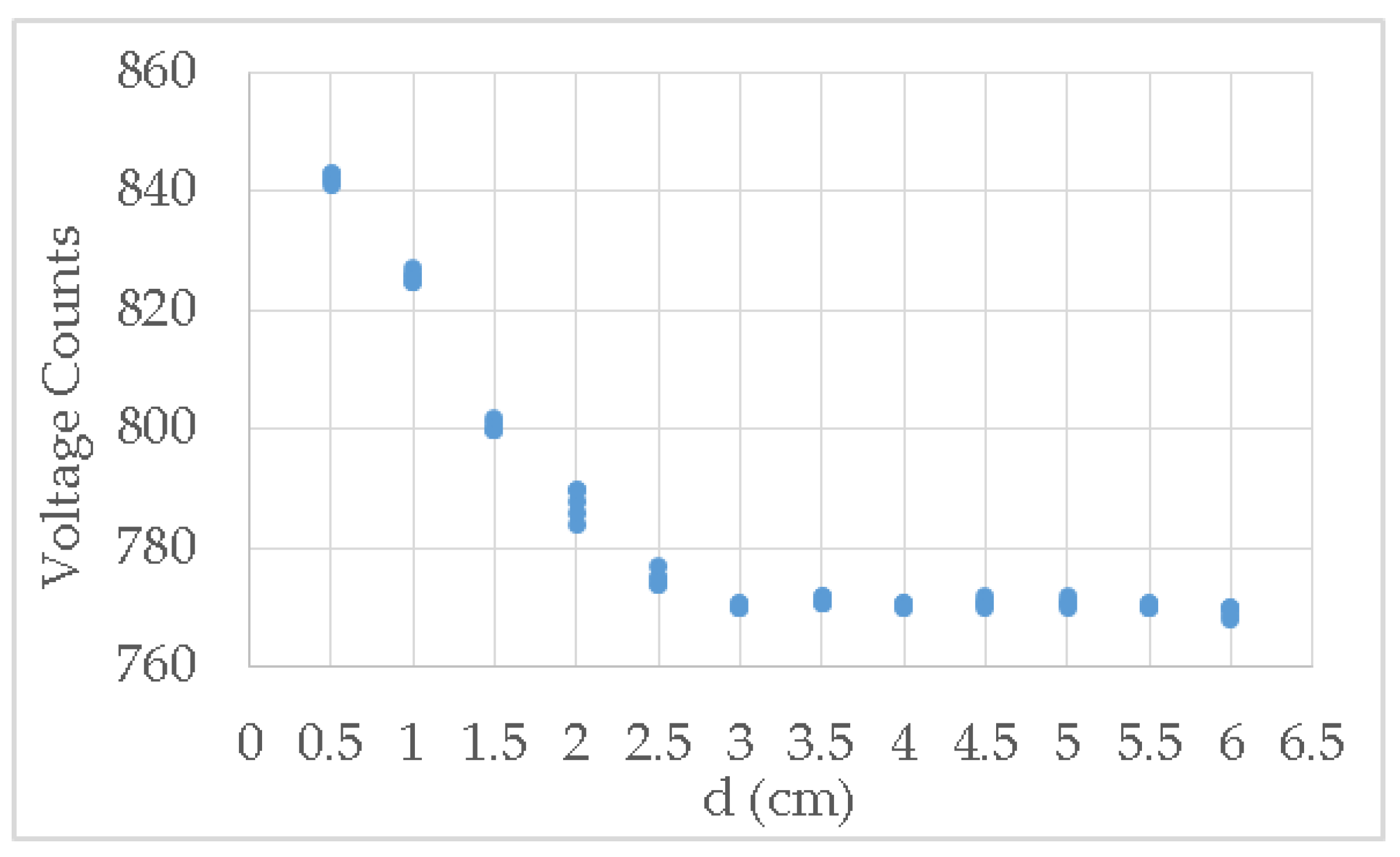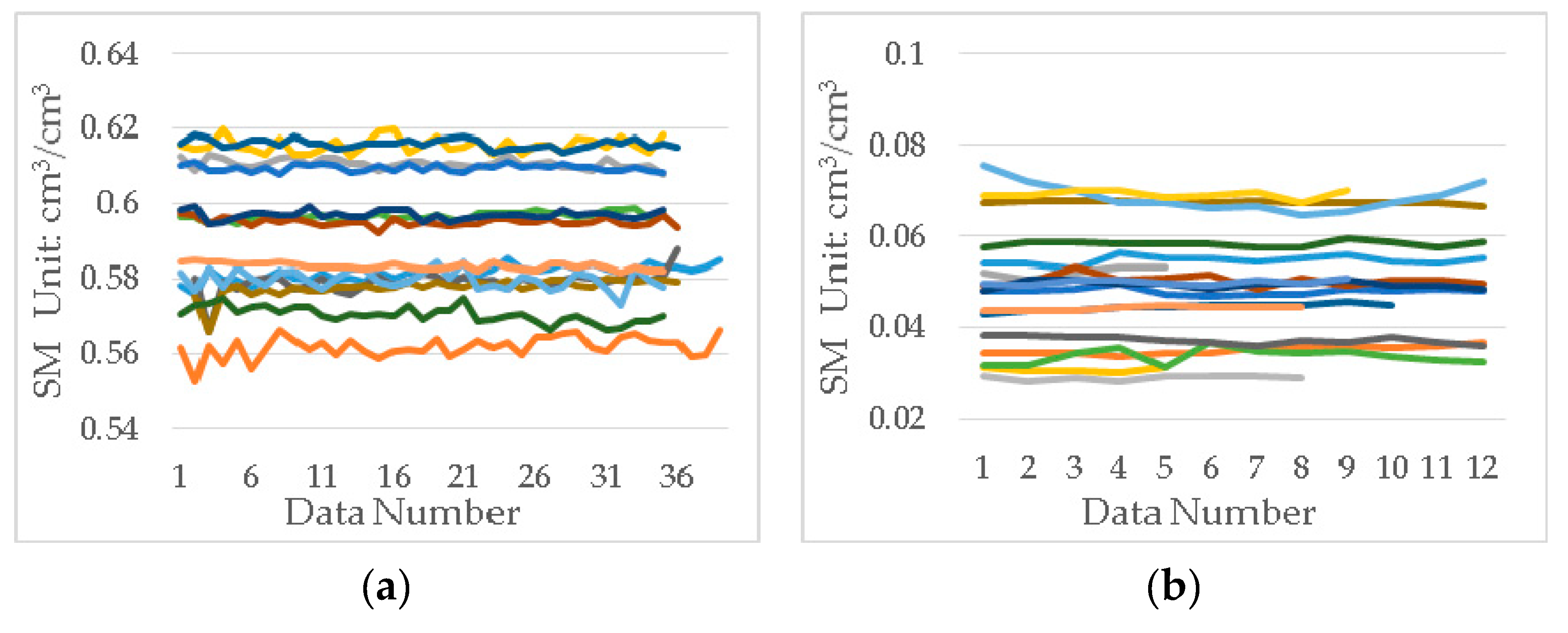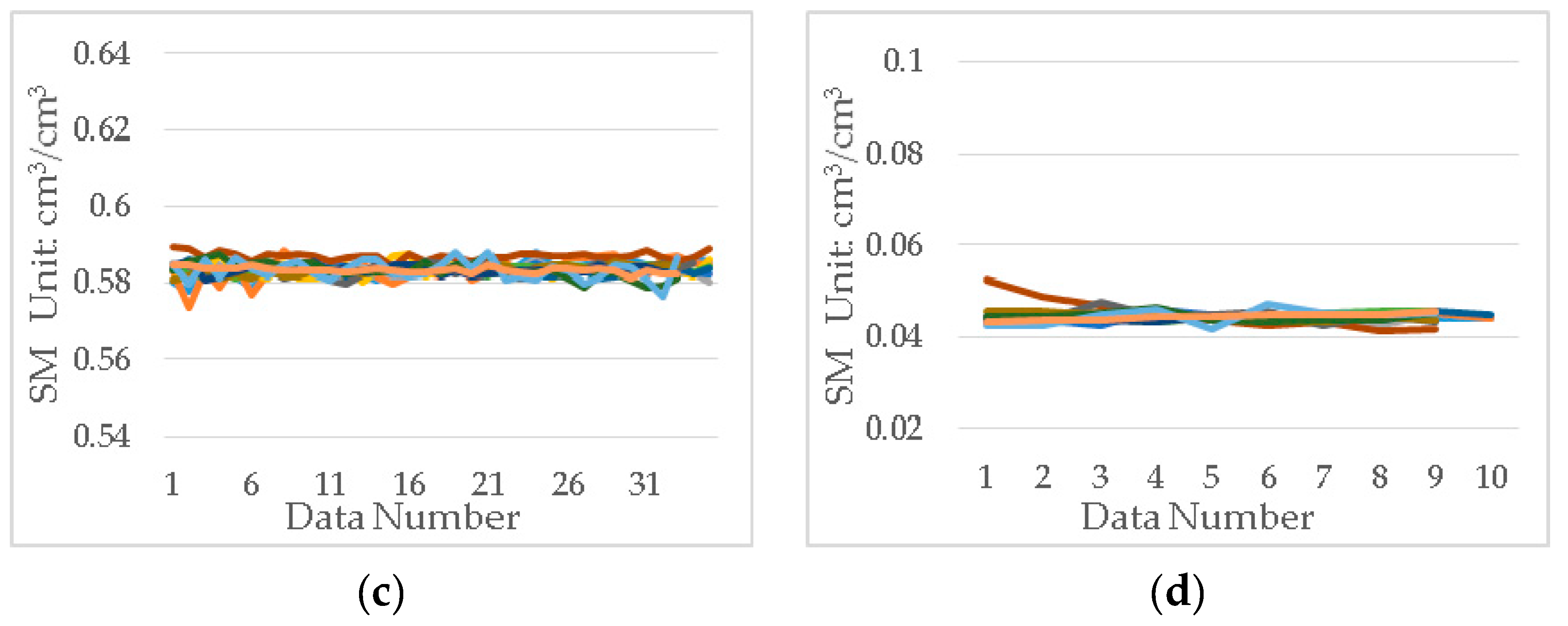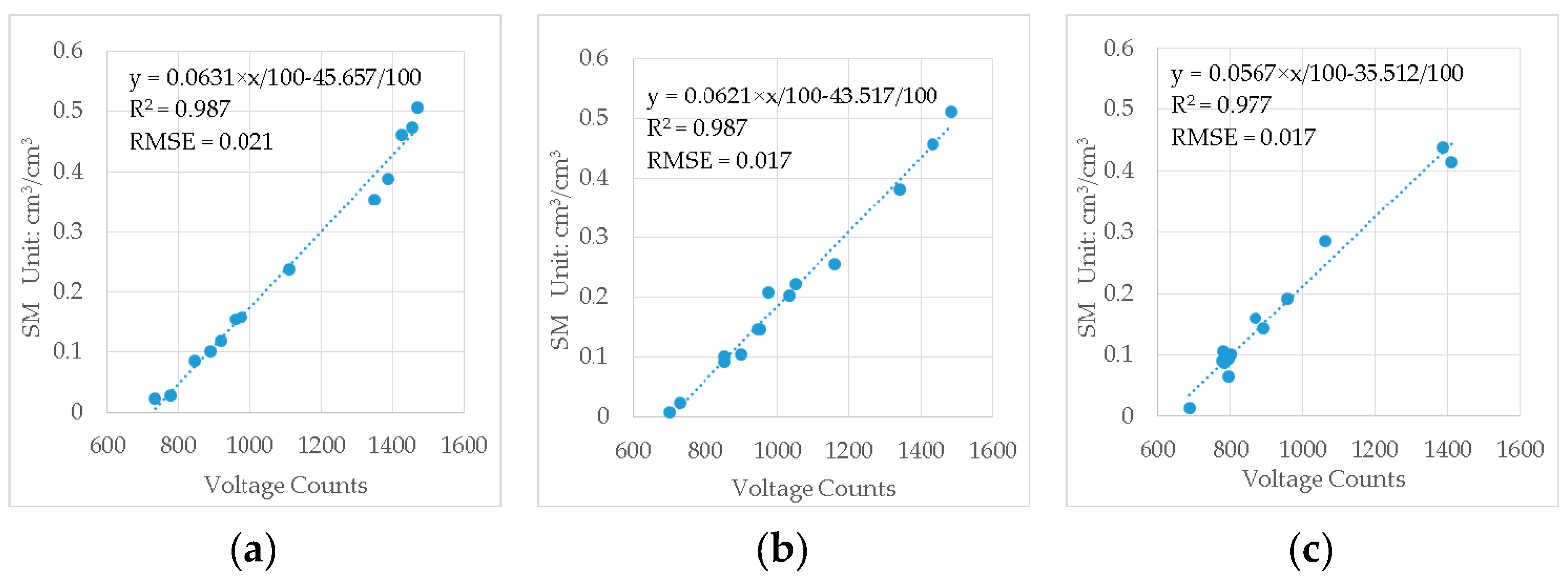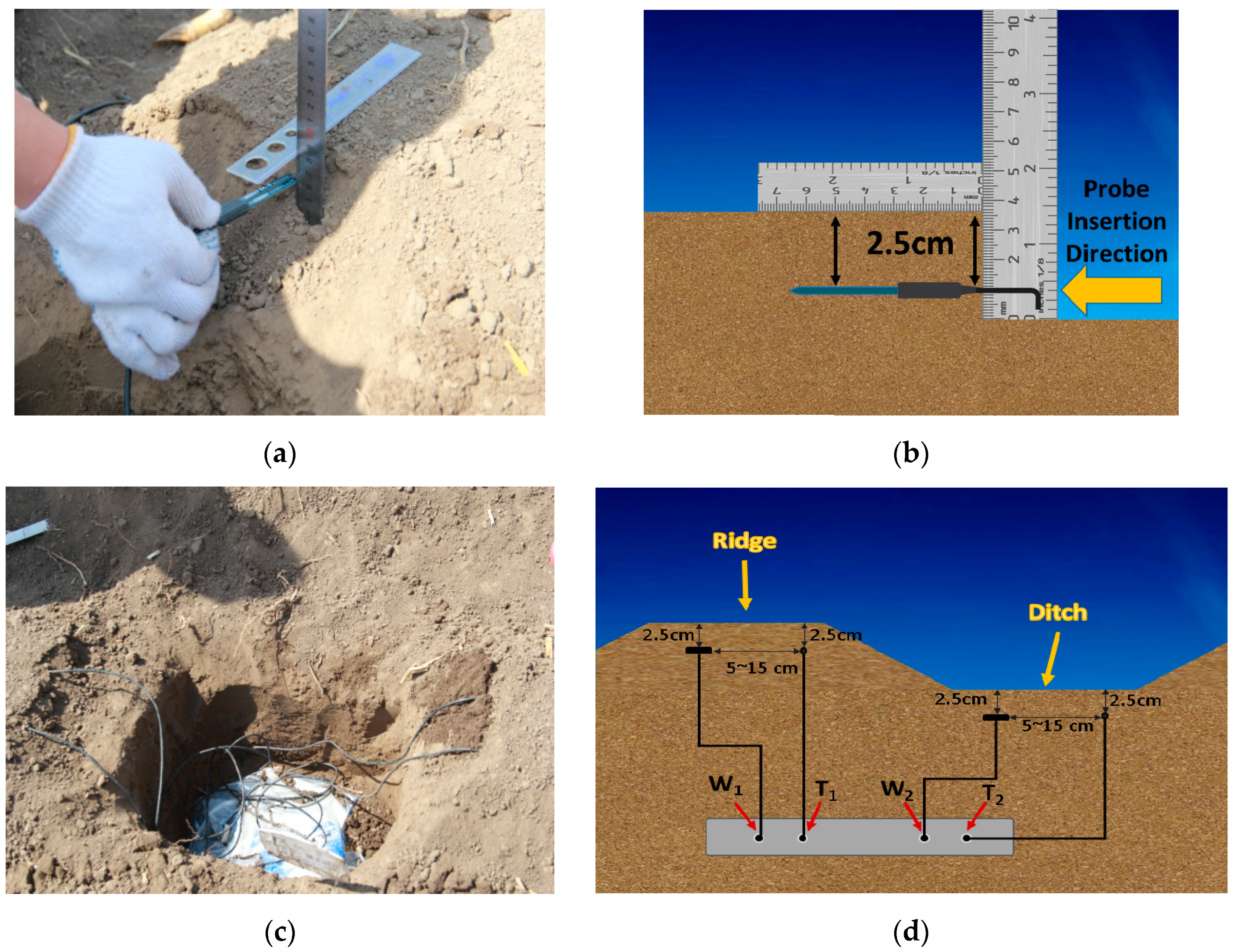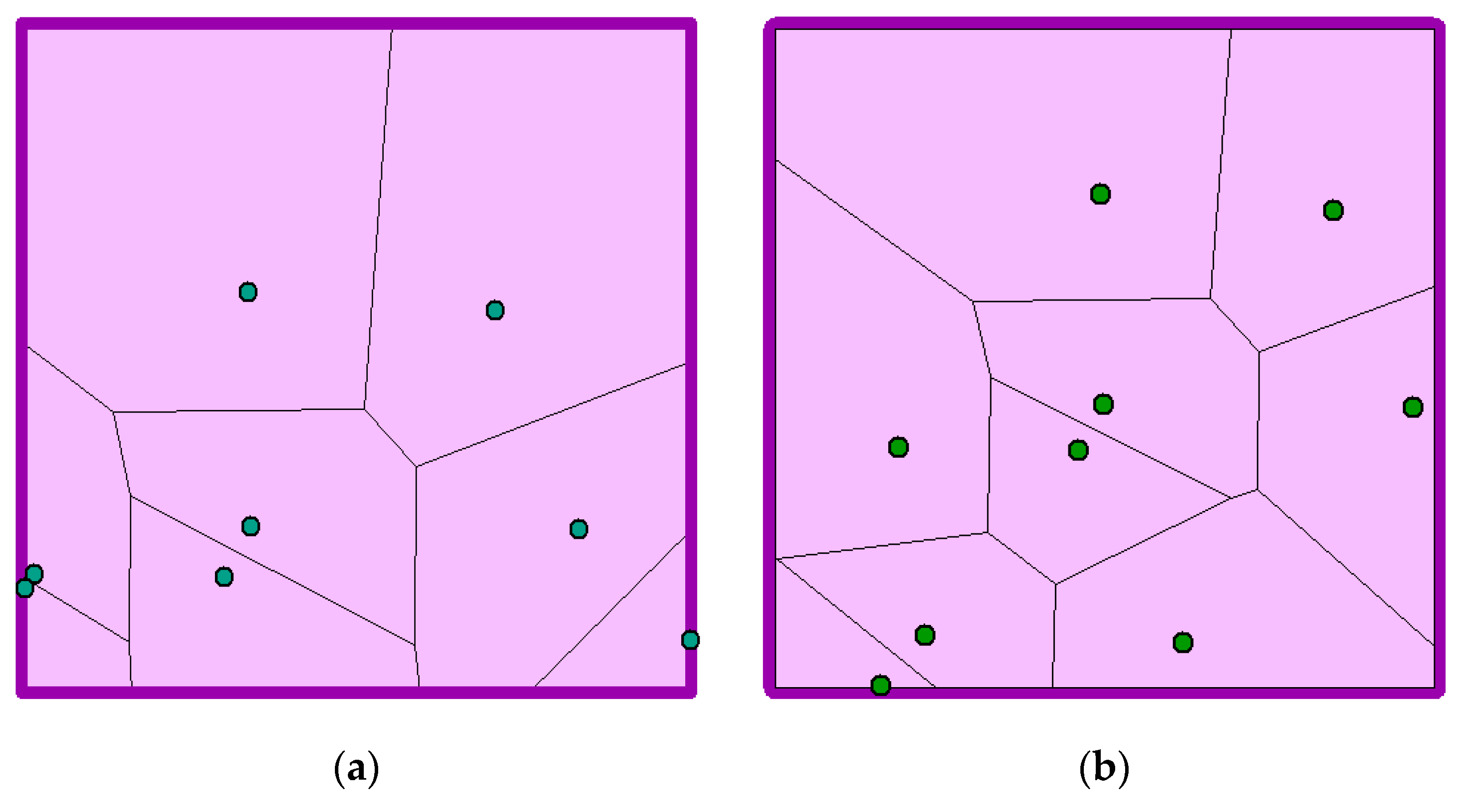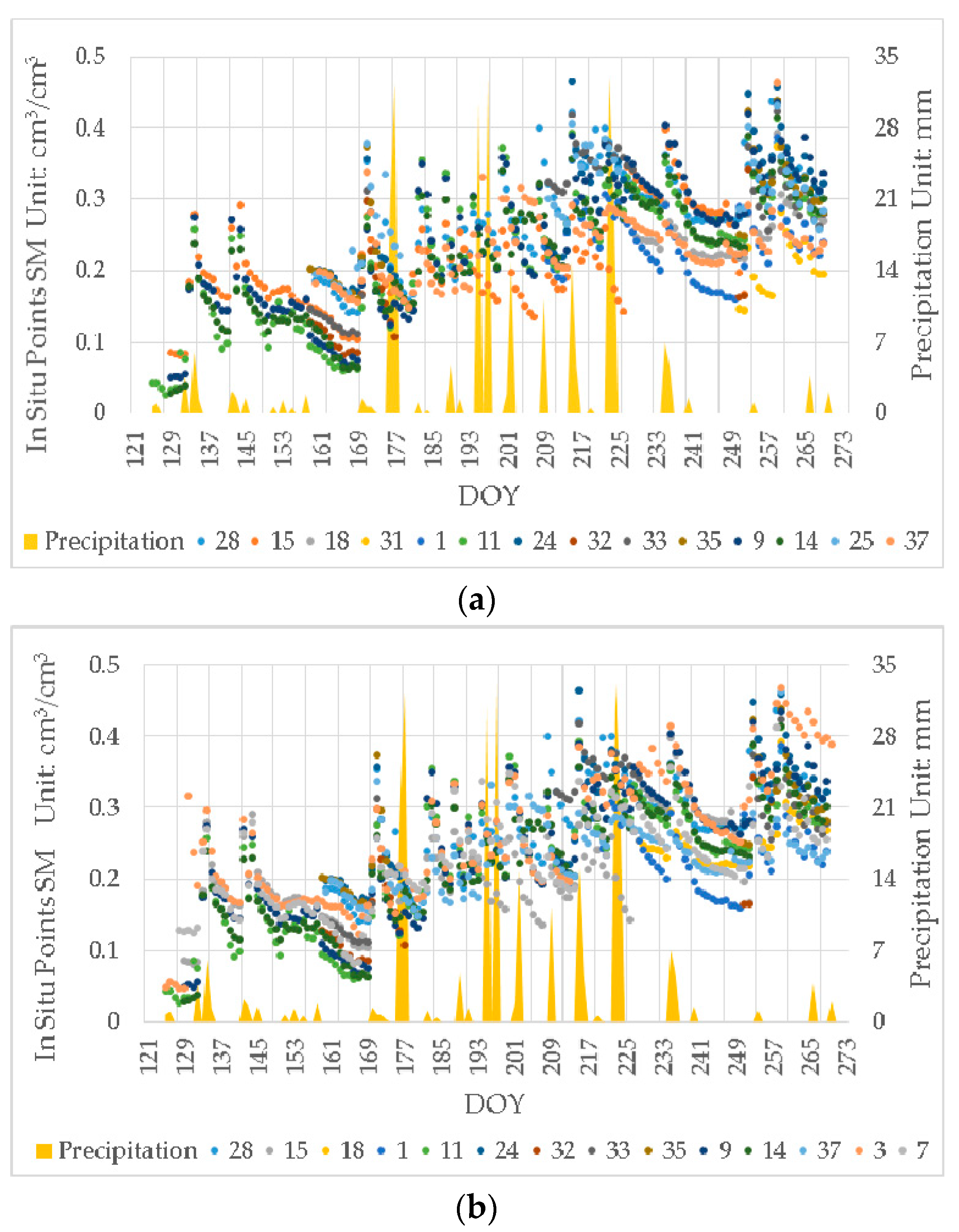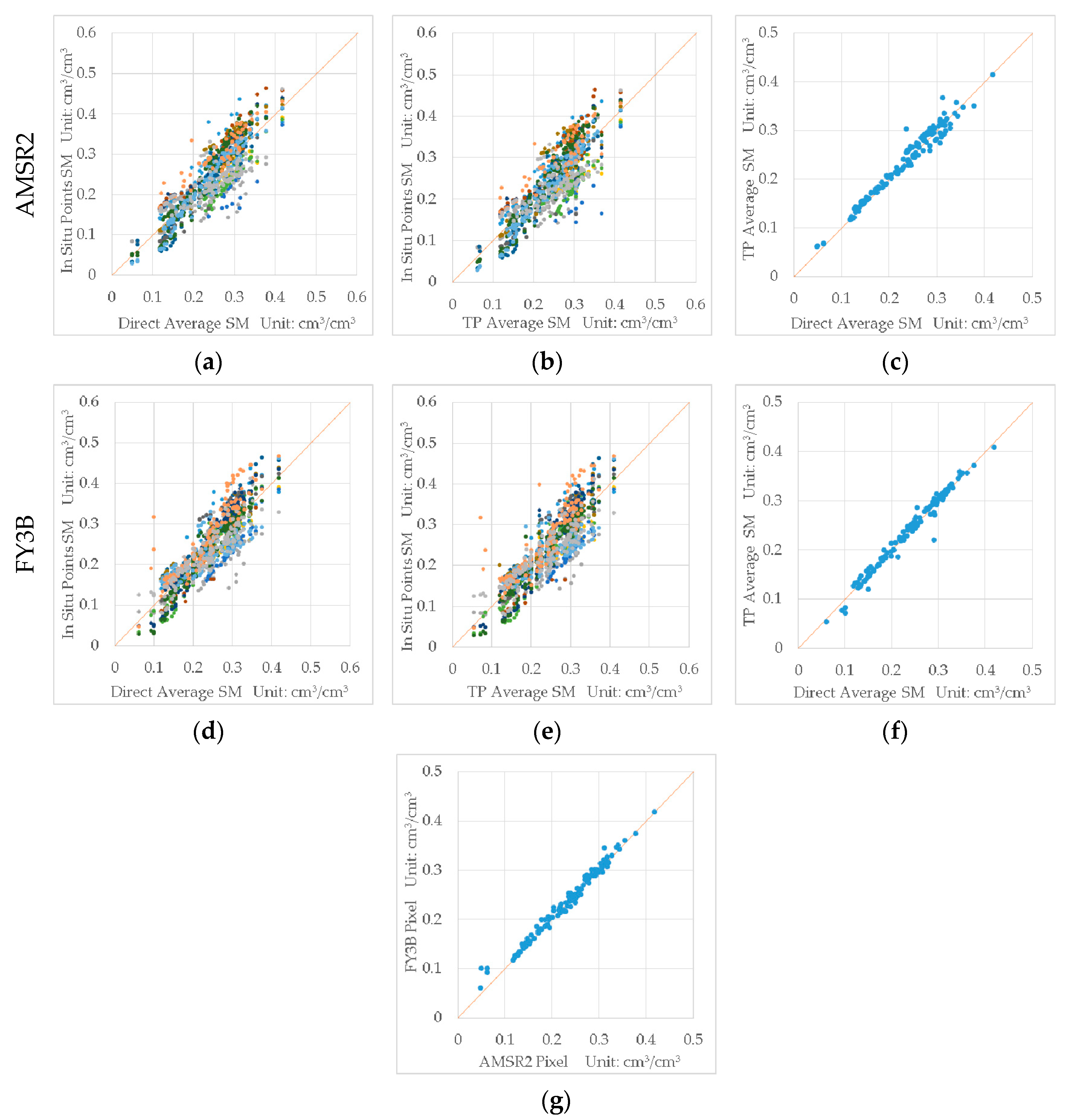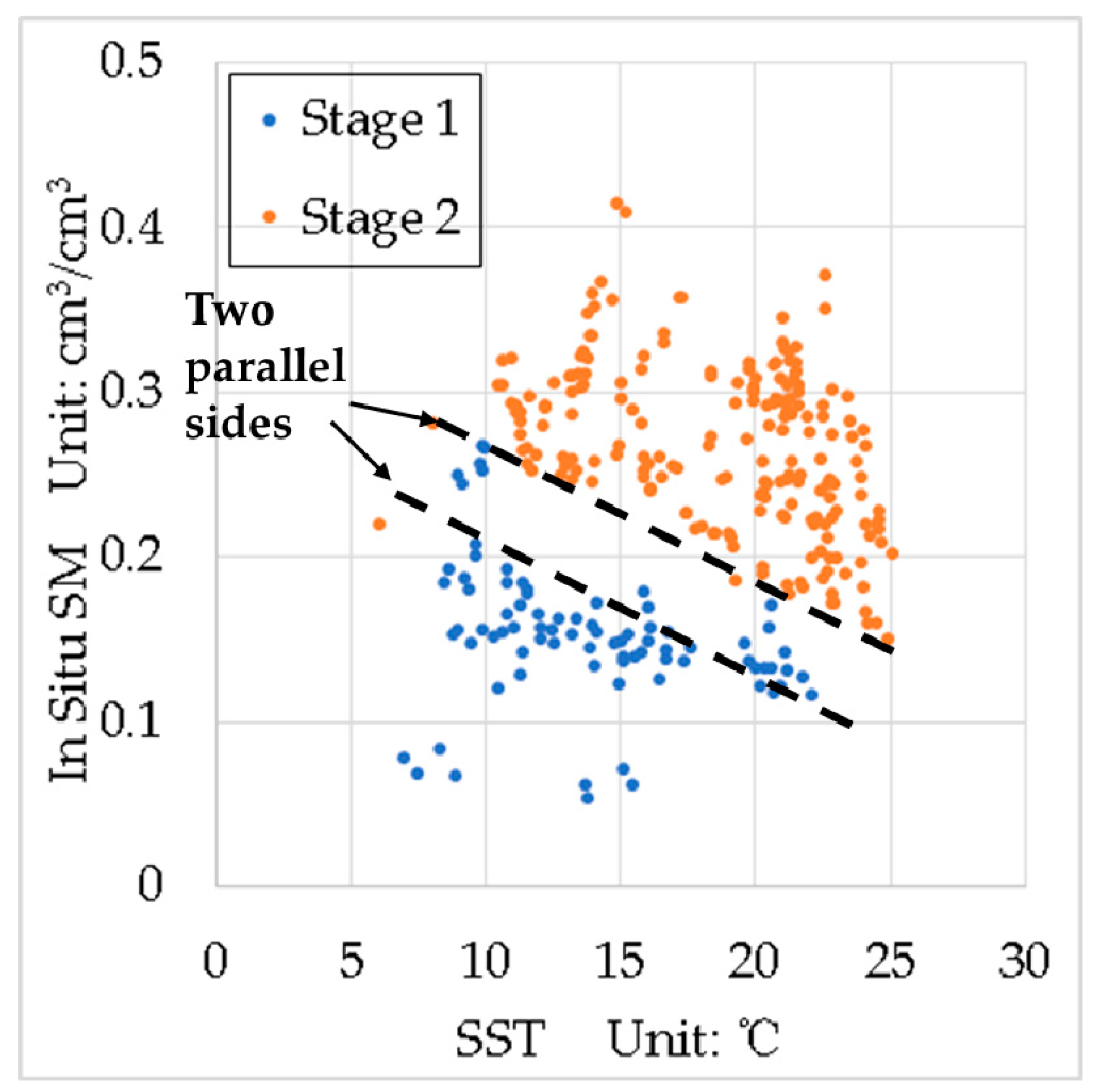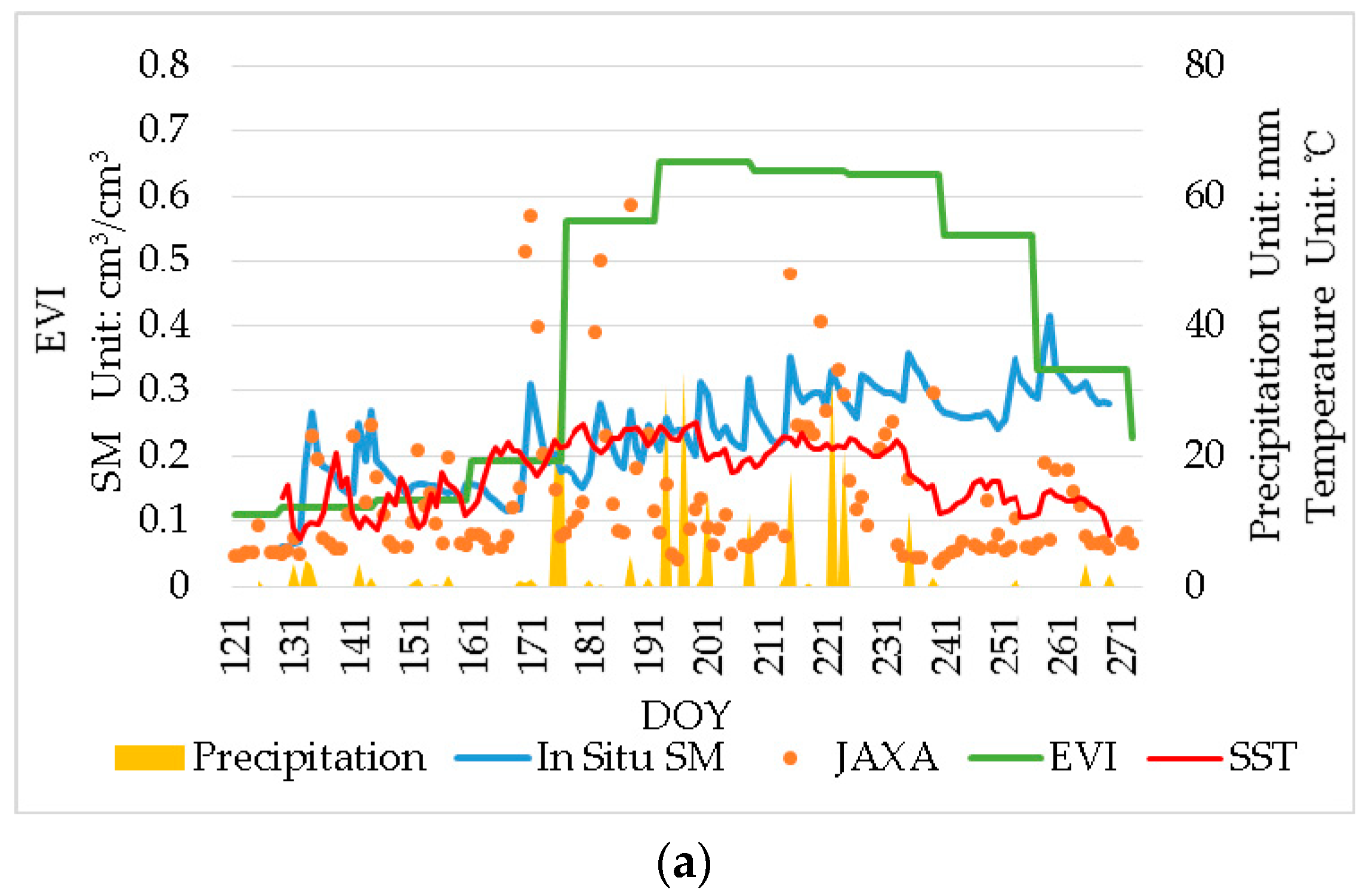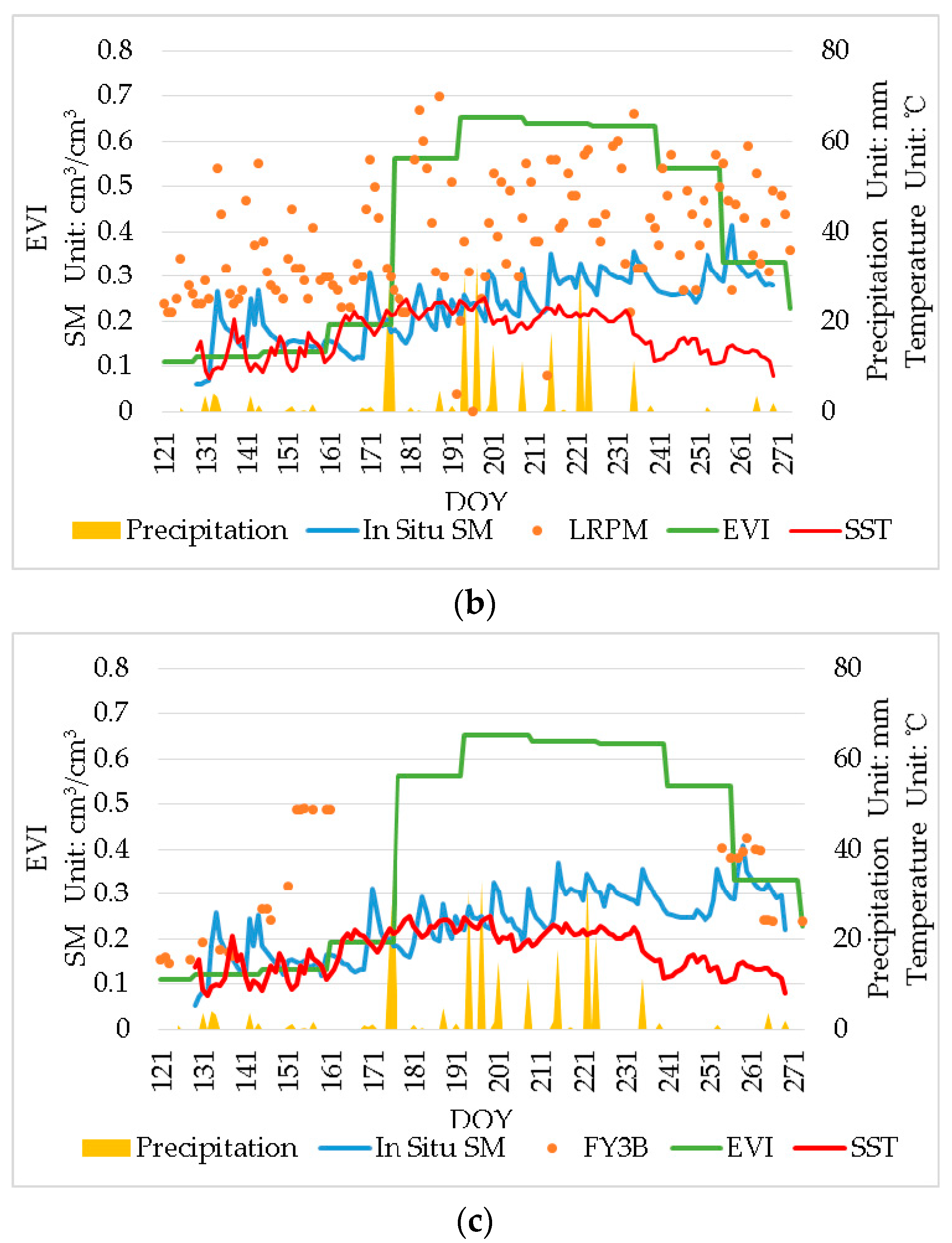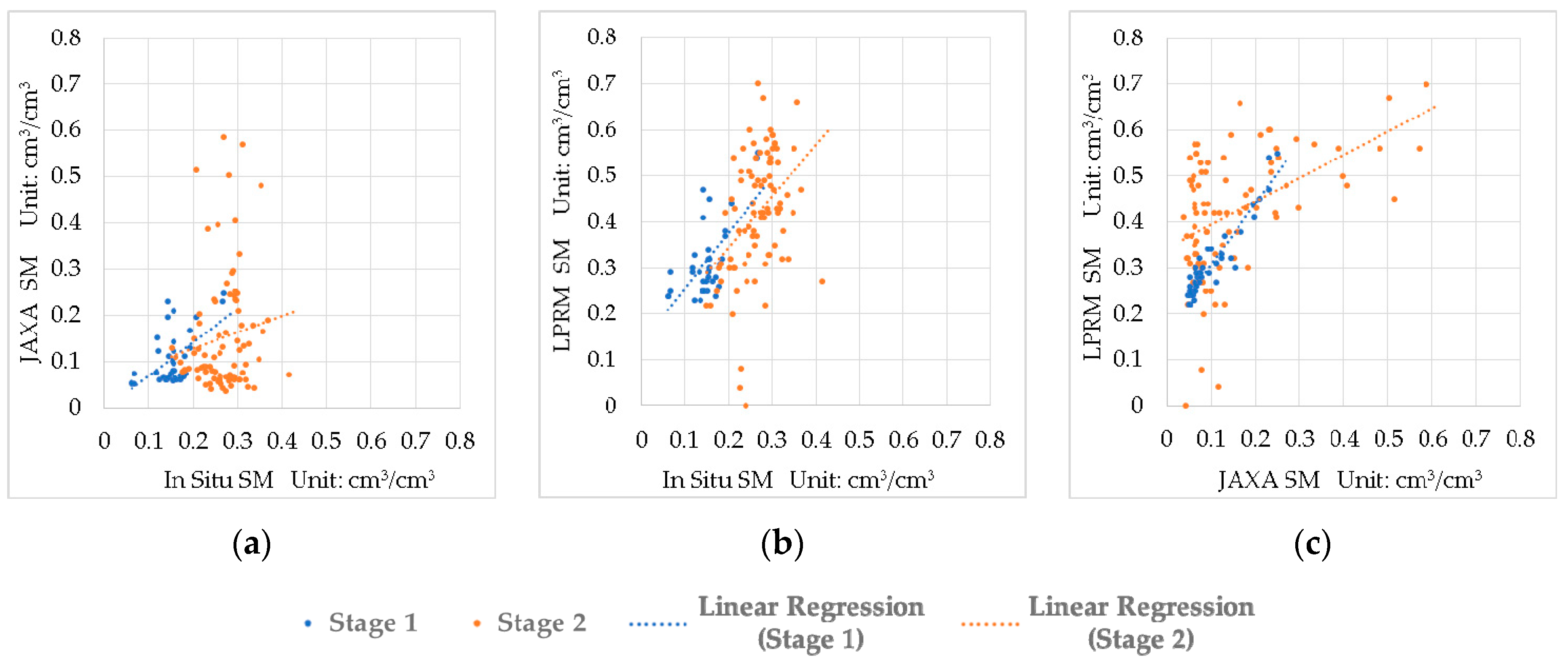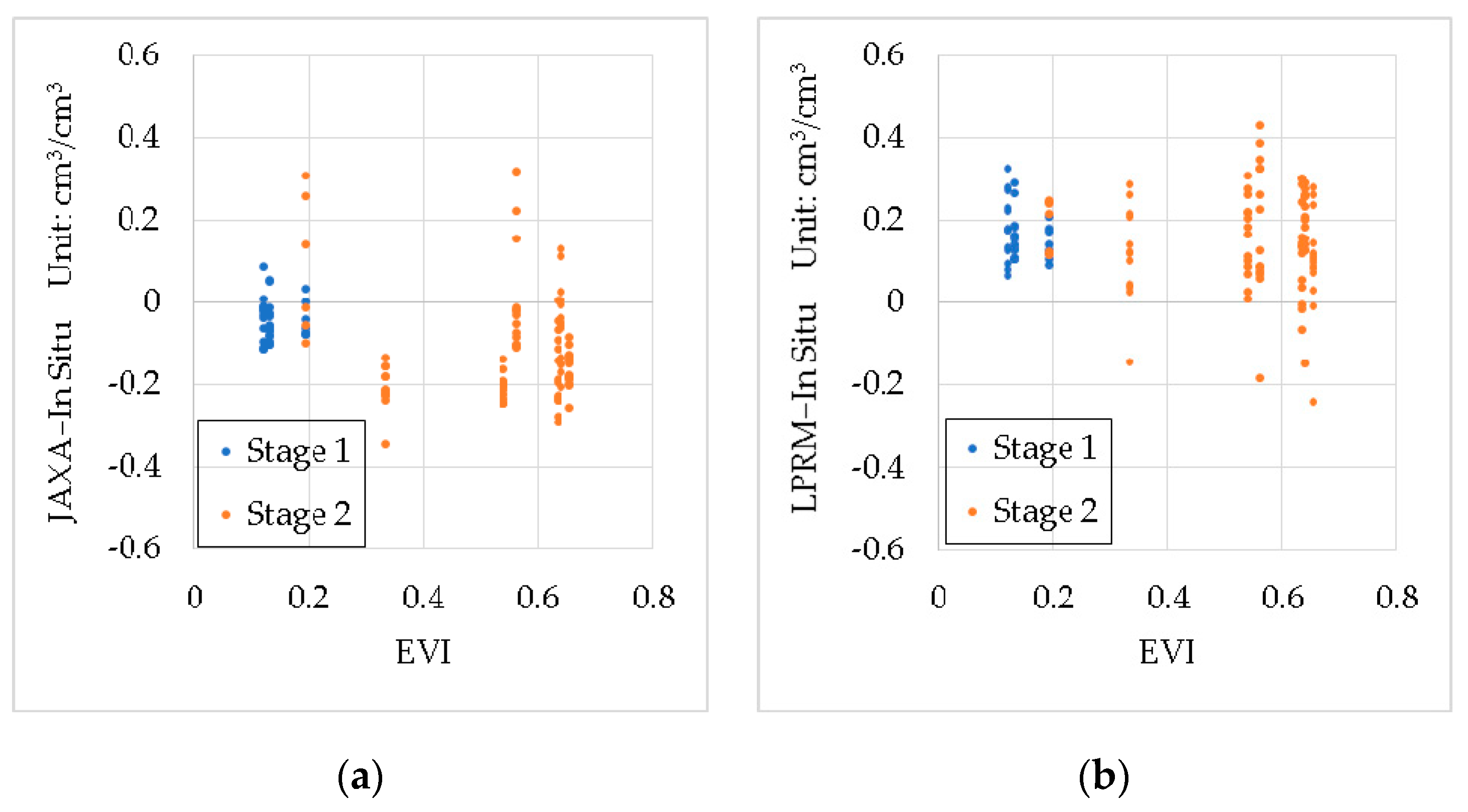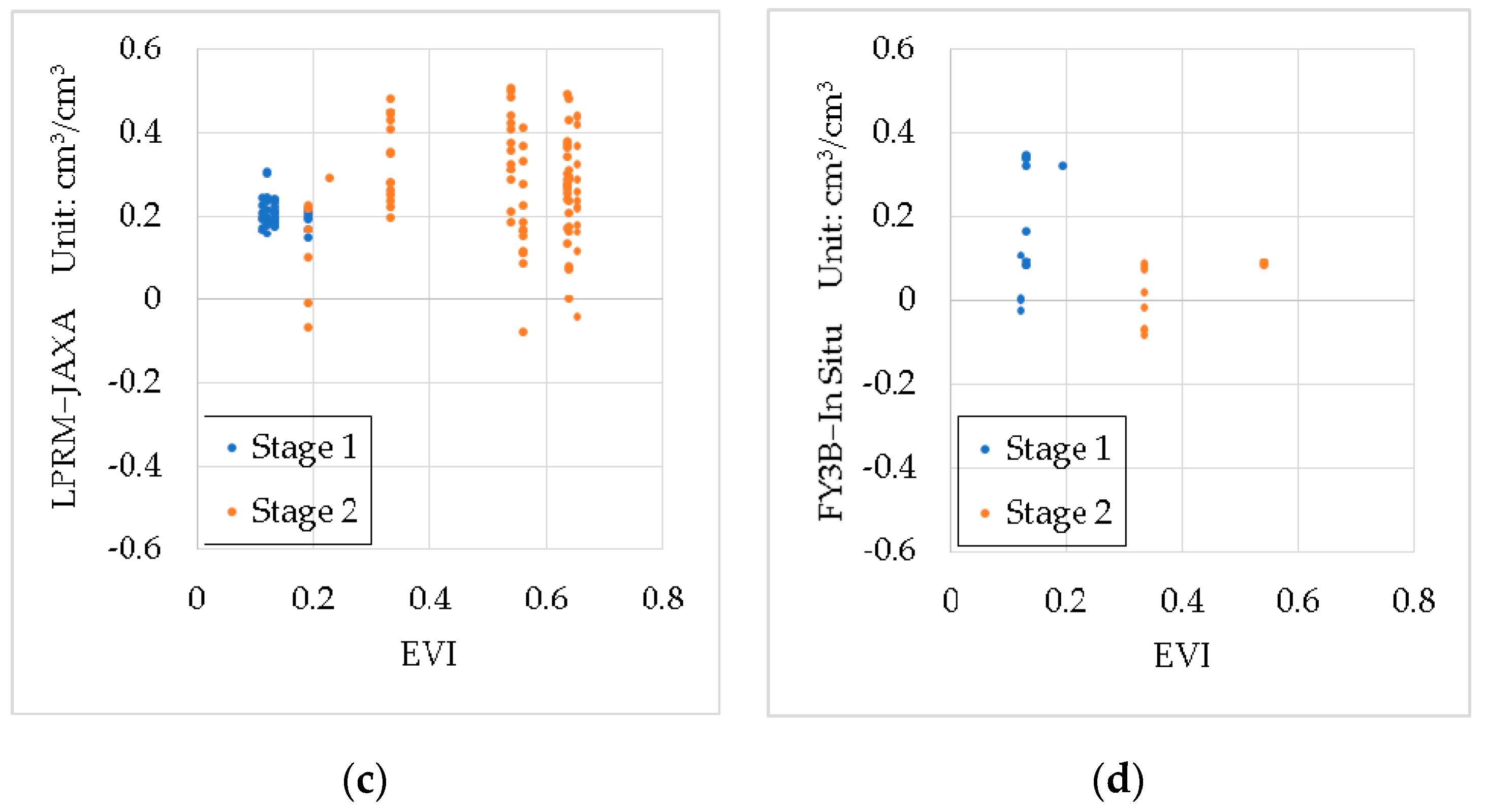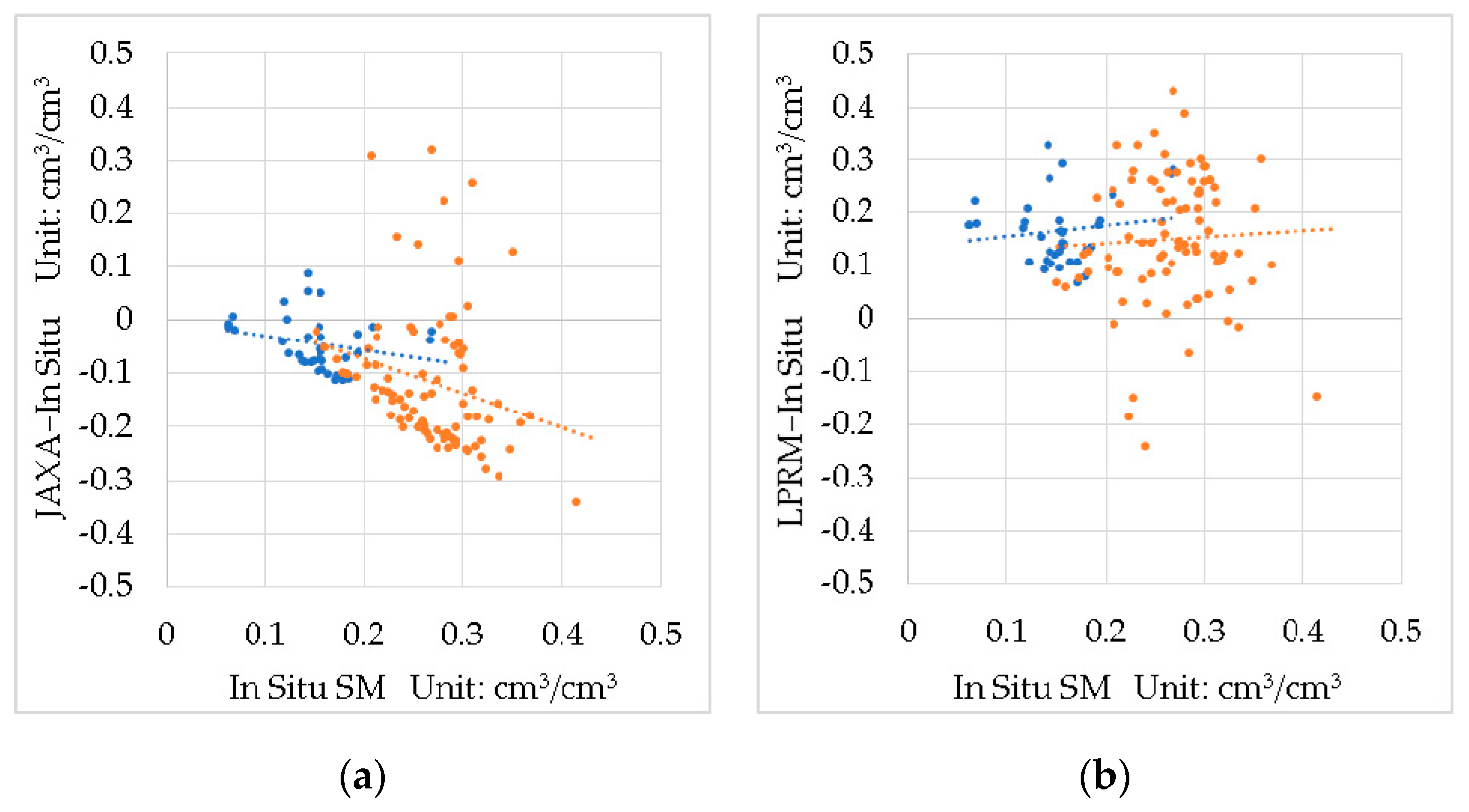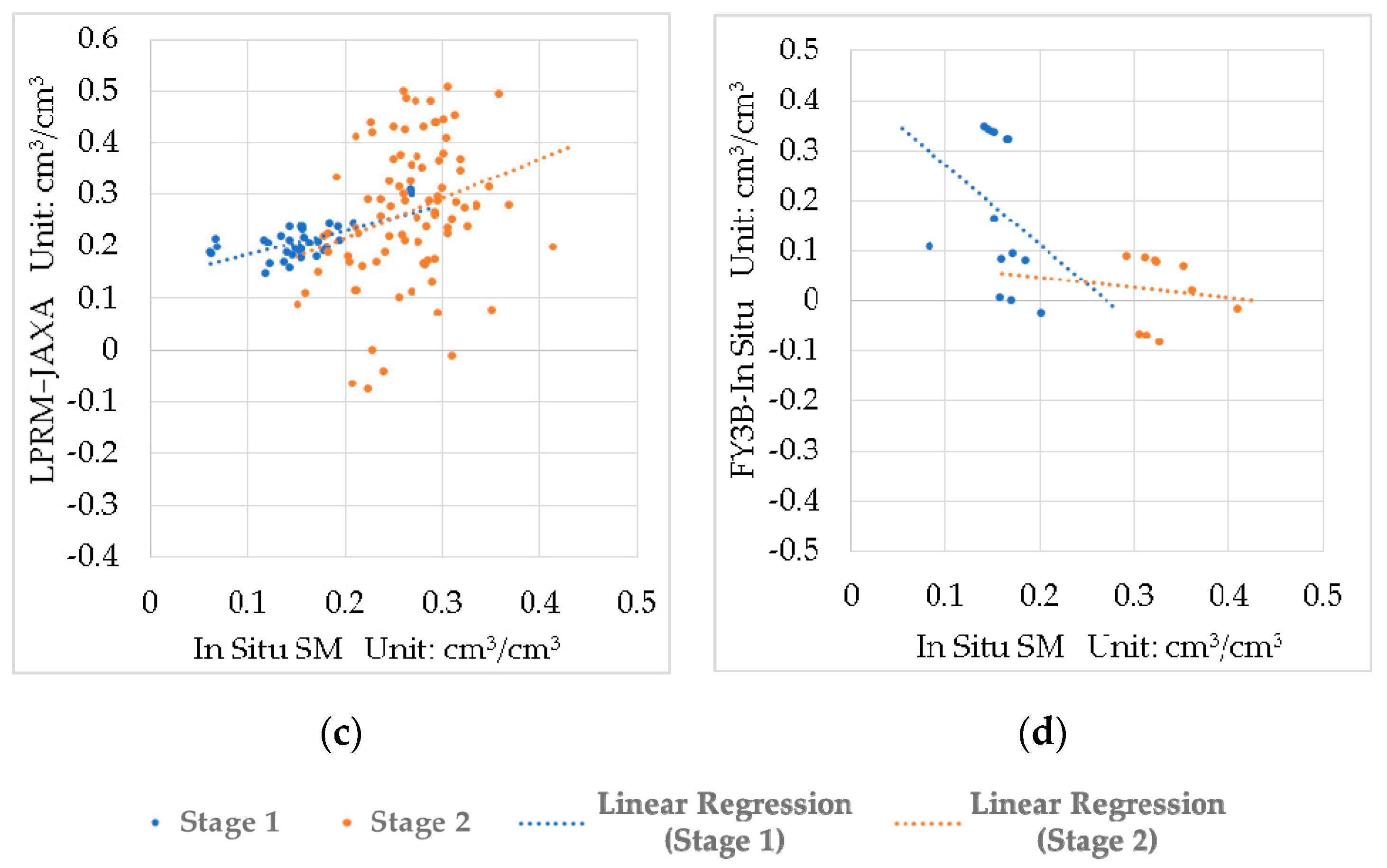Figure 1.
Study Area. (a) shows the geographical location of the study area in the northeast of China; (b) shows the distribution of the points from the in situ observation network, the satellite pixels in the study area. The background is a false-color Landsat 8 image at 25 September 2017 with band 5, 4, 3 as the RGB.
Figure 1.
Study Area. (a) shows the geographical location of the study area in the northeast of China; (b) shows the distribution of the points from the in situ observation network, the satellite pixels in the study area. The background is a false-color Landsat 8 image at 25 September 2017 with band 5, 4, 3 as the RGB.
Figure 2.
Location of each point in the in situ observation network and the distribution of soil types in the experimental area.
Figure 2.
Location of each point in the in situ observation network and the distribution of soil types in the experimental area.
Figure 3.
Inductive boundary test of EC-5 sensor. The plastic cylindrical container with a height of 30 cm and a diameter of 15 cm was filled with dry sand and placed in a bigger container filled with water to surround the plastic container. Insert the EC-5 probe into the dry sand completely, and gradually collect data from the edge to the center of the container. d was the distance from the probe to the edge of the small container.
Figure 3.
Inductive boundary test of EC-5 sensor. The plastic cylindrical container with a height of 30 cm and a diameter of 15 cm was filled with dry sand and placed in a bigger container filled with water to surround the plastic container. Insert the EC-5 probe into the dry sand completely, and gradually collect data from the edge to the center of the container. d was the distance from the probe to the edge of the small container.
Figure 4.
EC-5 sensor probe boundary measurement range experiment, the probe measurement voltage value changes with the probe distance d from the dry sand container boundary.
Figure 4.
EC-5 sensor probe boundary measurement range experiment, the probe measurement voltage value changes with the probe distance d from the dry sand container boundary.
Figure 5.
Consistency comparison and correction results of EC-5 sensors in ethyl alcohol and dry sand measurements, and different colored lines represent different sensors. (a) shows the data collected in ethanol, (b) shows the data collected in dry sand. (c) shows the ethanol data after correction, and (d) shows the dry sand data after correction.
Figure 5.
Consistency comparison and correction results of EC-5 sensors in ethyl alcohol and dry sand measurements, and different colored lines represent different sensors. (a) shows the data collected in ethanol, (b) shows the data collected in dry sand. (c) shows the ethanol data after correction, and (d) shows the dry sand data after correction.
Figure 6.
The calibration parameters and equations of the EC-5 sensor to the three soil types in the study area, wherein (a) is clay soil, (b) is sand silt soil, and (c) is sandy loam soil.
Figure 6.
The calibration parameters and equations of the EC-5 sensor to the three soil types in the study area, wherein (a) is clay soil, (b) is sand silt soil, and (c) is sandy loam soil.
Figure 7.
Installation and arrangement of the soil moisture and temperature sensors at in situ points. (a) shows the actual installation of the EC-5 probe, (b) describes the specific installation details of the EC-5 probe, (c) shows the situation of host and probes after installation, and (d) shows the position details of the probes and host. W1 and W2 are the EC-5 probes, and T1 and T2 are the temperature sensors.
Figure 7.
Installation and arrangement of the soil moisture and temperature sensors at in situ points. (a) shows the actual installation of the EC-5 probe, (b) describes the specific installation details of the EC-5 probe, (c) shows the situation of host and probes after installation, and (d) shows the position details of the probes and host. W1 and W2 are the EC-5 probes, and T1 and T2 are the temperature sensors.
Figure 8.
The comparison of NDVI and EVI in the study area during the study period. (a) shows the changes of NDVI and EVI during the study period, and (b) shows a linear relationship between NDVI and EVI.
Figure 8.
The comparison of NDVI and EVI in the study area during the study period. (a) shows the changes of NDVI and EVI during the study period, and (b) shows a linear relationship between NDVI and EVI.
Figure 9.
Thiessen Polygons calculated from the spatial distribution of the in situ points of soil moisture in microwave pixels, where (a) is the AMSR2 pixel with a spatial resolution of 0.25 degrees and a total of 8 in situ points, and (b) is the FY3B pixel with a spatial resolution of 0.25 degrees and a total of 9 in situ points.
Figure 9.
Thiessen Polygons calculated from the spatial distribution of the in situ points of soil moisture in microwave pixels, where (a) is the AMSR2 pixel with a spatial resolution of 0.25 degrees and a total of 8 in situ points, and (b) is the FY3B pixel with a spatial resolution of 0.25 degrees and a total of 9 in situ points.
Figure 10.
Measured soil moisture data from the in situ observation network and the cumulative 24-hour precipitation. Among them, (a) is the AMSR2 pixel case, and (b) is the FY3B pixel case. The numbers shown at the bottom of the figure are the sensors’ numbers.
Figure 10.
Measured soil moisture data from the in situ observation network and the cumulative 24-hour precipitation. Among them, (a) is the AMSR2 pixel case, and (b) is the FY3B pixel case. The numbers shown at the bottom of the figure are the sensors’ numbers.
Figure 11.
The comparison of the in situ point soil moisture data and the up-scaled results in the study area. (a,d) are respectively the comparison of the in situ soil moisture at each point and the direct average in the AMSR2 pixel and the FY3B pixel. (b,e) are respectively the comparison of the in situ soil moisture at each point and the result of Thiessen Polygons method in the AMSR2 pixel and the FY3B pixel. (c,f) are respectively the comparison of the direct average and the result of Thiessen Polygons method in the AMSR2 pixel and the FY3B pixel. (g) is the comparison of the results of Thiessen Polygons method in AMSR2 pixel and FY3B pixel.
Figure 11.
The comparison of the in situ point soil moisture data and the up-scaled results in the study area. (a,d) are respectively the comparison of the in situ soil moisture at each point and the direct average in the AMSR2 pixel and the FY3B pixel. (b,e) are respectively the comparison of the in situ soil moisture at each point and the result of Thiessen Polygons method in the AMSR2 pixel and the FY3B pixel. (c,f) are respectively the comparison of the direct average and the result of Thiessen Polygons method in the AMSR2 pixel and the FY3B pixel. (g) is the comparison of the results of Thiessen Polygons method in AMSR2 pixel and FY3B pixel.
Figure 12.
The relationship between the in situ soil moisture and the SST. Both of the in situ soil moisture in the AMSR2 and FY3B pixels are shown in the figure at two different stages. There are two parallel lines separately on the upper side of the data at the first stage and on the bottom side of the data at the second stage, and there is an obvious space between the two sides.
Figure 12.
The relationship between the in situ soil moisture and the SST. Both of the in situ soil moisture in the AMSR2 and FY3B pixels are shown in the figure at two different stages. There are two parallel lines separately on the upper side of the data at the first stage and on the bottom side of the data at the second stage, and there is an obvious space between the two sides.
Figure 13.
The change of soil moisture products with in situ soil moisture, daily precipitation, EVI, and surface soil temperature. Among them, (a) is about the JAXA soil moisture product, (b) is about the LPRM soil moisture product, and (c) is about the FY3B soil moisture product.
Figure 13.
The change of soil moisture products with in situ soil moisture, daily precipitation, EVI, and surface soil temperature. Among them, (a) is about the JAXA soil moisture product, (b) is about the LPRM soil moisture product, and (c) is about the FY3B soil moisture product.
Figure 14.
Comparisons between the JAXA product, the LPRM product, and the in situ soil moisture in two stages. (a) is the comparison between the JAXA product and the in situ soil moisture. (b) is the comparison between the LPRM product and the in situ soil moisture. (c) is the comparison between the two AMSR2 products.
Figure 14.
Comparisons between the JAXA product, the LPRM product, and the in situ soil moisture in two stages. (a) is the comparison between the JAXA product and the in situ soil moisture. (b) is the comparison between the LPRM product and the in situ soil moisture. (c) is the comparison between the two AMSR2 products.
Figure 15.
The effect of the EVI to the soil moisture products. (a) is the difference between the JAXA product and the in situ soil moisture with the EVI, (b) is the difference between the LPRM product and the in situ soil moisture with the EVI, (c) is the difference between LPRM product and the JAXA product with the EVI, and (d) is the difference between the FY3B product and the in situ soil moisture with the EVI.
Figure 15.
The effect of the EVI to the soil moisture products. (a) is the difference between the JAXA product and the in situ soil moisture with the EVI, (b) is the difference between the LPRM product and the in situ soil moisture with the EVI, (c) is the difference between LPRM product and the JAXA product with the EVI, and (d) is the difference between the FY3B product and the in situ soil moisture with the EVI.
Figure 16.
The effect of the SST to the soil moisture products. (a) shows the JAXA product with the SST, (b) shows the LPRM product with the SST, (c) shows the difference between the JAXA product and the in situ soil moisture with the SST, (d) shows the difference between the LPRM product and the in situ soil moisture with the SST, and (e) shows the difference between the LPRM and the JAXA products with the SST.
Figure 16.
The effect of the SST to the soil moisture products. (a) shows the JAXA product with the SST, (b) shows the LPRM product with the SST, (c) shows the difference between the JAXA product and the in situ soil moisture with the SST, (d) shows the difference between the LPRM product and the in situ soil moisture with the SST, and (e) shows the difference between the LPRM and the JAXA products with the SST.
Figure 17.
The effect of the actual soil moisture to the soil moisture products. (a) shows the difference between the JAXA product and the in situ soil moisture with the in situ soil moisture, (b) shows the difference between the LPRM product and the in situ soil moisture with the in situ soil moisture, (c) shows the difference between the LPRM product and the JAXA product with the in situ soil moisture, and (d) is the difference between the FY3B product and the in situ soil moisture with the in situ soil moisture.
Figure 17.
The effect of the actual soil moisture to the soil moisture products. (a) shows the difference between the JAXA product and the in situ soil moisture with the in situ soil moisture, (b) shows the difference between the LPRM product and the in situ soil moisture with the in situ soil moisture, (c) shows the difference between the LPRM product and the JAXA product with the in situ soil moisture, and (d) is the difference between the FY3B product and the in situ soil moisture with the in situ soil moisture.
Table 1.
Content of each component in different classification of soil samples.
Table 1.
Content of each component in different classification of soil samples.
| Soil Texture | Clay (%) | Silt (%) | Sand (%) |
|---|
| Sandy Loam Soil | 12.41 | 64.28 | 23.31 |
| Clay Soil | 11.80 | 57.71 | 30.48 |
| Sandy Silt Soil | 11.81 | 55.87 | 32.32 |
Table 2.
Parameters of the EC-5 sensor after testing and calibration.
Table 2.
Parameters of the EC-5 sensor after testing and calibration.
| Sensing Range (cm) | 2.5~3 |
| Operating Temperature (°C) | −40~+60 |
| Measurement Range of SM (%) | 0~100 |
| Accuracy (cm3/cm3) | 0.02 |
Table 3.
The performance metrics of the JAXA and the LPRM soil moisture products at different study periods. The best one for each performance metric is in bold.
Table 3.
The performance metrics of the JAXA and the LPRM soil moisture products at different study periods. The best one for each performance metric is in bold.
| Period | Products | RMSE (cm3/cm3) | ubRMSE (cm3/cm3) | b (cm3/cm3) | R |
|---|
| Whole Period | JAXA | 0.150 | 0.117 | −0.094 | 0.259 |
| LPRM | 0.191 | 0.110 | 0.156 | 0.542 |
| First Stage | JAXA | 0.066 | 0.049 | −0.043 | 0.565 |
| LPRM | 0.177 | 0.063 | 0.166 | 0.654 |
| Second Stage | JAXA | 0.173 | 0.129 | −0.115 | 0.136 |
| LPRM | 0.196 | 0.124 | 0.152 | 0.403 |
Table 4.
The comparison of the performance metrics of the three soil moisture products as the period of the FY3B product. The best one for each performance metric is in bold.
Table 4.
The comparison of the performance metrics of the three soil moisture products as the period of the FY3B product. The best one for each performance metric is in bold.
| Period | Products | RMSE (cm3/cm3) | ubRMSE (cm3/cm3) | b (cm3/cm3) | R |
|---|
| as FY3B | FY3B | 0.237 | 0.155 | 0.179 | 0.042 |
| JAXA | 0.231 | 0.085 | 0.215 | 0.180 |
| LPRM | 0.233 | 0.156 | 0.174 | 0.516 |
